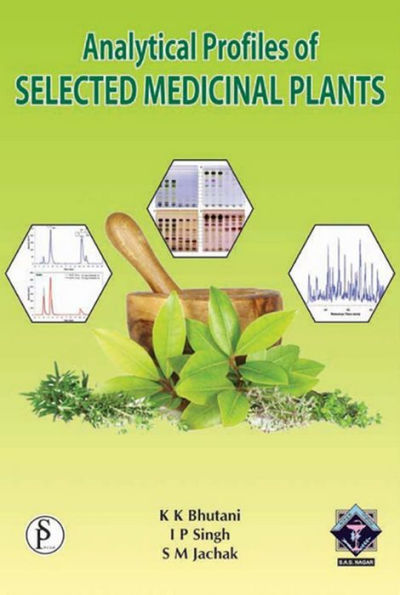Analytical Profiles Of Selected Medicinal Plants
Since ancient times, herbals have been the mainstay of folkloric medicines all around the world. Traditional systems of medicines around the world have integrated phytotherapy into their doctrine. However, the use of phytotherapy fails to fit into the efficacy and safety criteria established for contemporary medicine. High quality standards products are needed to allow the patient to make safe use of phytotherapeutic products. Standardization of herbal medicines helps develop a set of standards or intrinsic characteristics that carry an assurance of quality and reproducibility Since ancient times, herbals have been the mainstay of folkloric medicines all around the world. Traditional systems of medicines around the world have integrated phytotherapy into their doctrine. However, the use of phytotherapy fails to fit into the efficacy and safety criteria established for contemporary medicine. High quality standards products are needed to allow the patient to make safe use of phytotherapeutic products. Standardization of herbal medicines helps develop a set of standards or intrinsic characteristics that carry an assurance of quality and reproducibility of herbal preparation. Specific standards are worked out by experimentation, which would lead to the process of stipulating an individuality exhibited by the particular herbal medicine. Hence standardization is a tool in the quality control process The present book is a small step towards this goal. In this book, standardization and identification of the marker compounds in medicinal plants have been carried out using analytical techniques starting from basic and cost effective to highly sophisticated ones. Although, HPLC is considered more specific and better technique, TLC still remains a versatile and valuable analytical tool due to its high-throughput and cost-effectiveness for plant analysis. Several studies have indicated a poor quality control and batch to batch variations in the marketed traditional preparations thereby necessitating the use of these analytical tools for quality control. LC-MS, a technique that combines the physical separation capabilities of liquid chromatography with the mass analysis capabilities of mass spectrometry (MS) and is known for its high sensitivity, has also found extensive usage in fingerprinting of plant extracts, but has not been used much for the quality control purpose of traditional medicines or herbal products. We believe that the importance of QNMR in analysis of botanicals will grow immensely as it does not require the pure reference markers for the preparation of calibration curves for the purpose of quantitative analysis. This book includes quantitative analysis of markers in 20 plants with TLC, 43 plants with HPLC, 29 plants with LC-MS and 8 plants using QNMR.
"1136006980"
Analytical Profiles Of Selected Medicinal Plants
Since ancient times, herbals have been the mainstay of folkloric medicines all around the world. Traditional systems of medicines around the world have integrated phytotherapy into their doctrine. However, the use of phytotherapy fails to fit into the efficacy and safety criteria established for contemporary medicine. High quality standards products are needed to allow the patient to make safe use of phytotherapeutic products. Standardization of herbal medicines helps develop a set of standards or intrinsic characteristics that carry an assurance of quality and reproducibility Since ancient times, herbals have been the mainstay of folkloric medicines all around the world. Traditional systems of medicines around the world have integrated phytotherapy into their doctrine. However, the use of phytotherapy fails to fit into the efficacy and safety criteria established for contemporary medicine. High quality standards products are needed to allow the patient to make safe use of phytotherapeutic products. Standardization of herbal medicines helps develop a set of standards or intrinsic characteristics that carry an assurance of quality and reproducibility of herbal preparation. Specific standards are worked out by experimentation, which would lead to the process of stipulating an individuality exhibited by the particular herbal medicine. Hence standardization is a tool in the quality control process The present book is a small step towards this goal. In this book, standardization and identification of the marker compounds in medicinal plants have been carried out using analytical techniques starting from basic and cost effective to highly sophisticated ones. Although, HPLC is considered more specific and better technique, TLC still remains a versatile and valuable analytical tool due to its high-throughput and cost-effectiveness for plant analysis. Several studies have indicated a poor quality control and batch to batch variations in the marketed traditional preparations thereby necessitating the use of these analytical tools for quality control. LC-MS, a technique that combines the physical separation capabilities of liquid chromatography with the mass analysis capabilities of mass spectrometry (MS) and is known for its high sensitivity, has also found extensive usage in fingerprinting of plant extracts, but has not been used much for the quality control purpose of traditional medicines or herbal products. We believe that the importance of QNMR in analysis of botanicals will grow immensely as it does not require the pure reference markers for the preparation of calibration curves for the purpose of quantitative analysis. This book includes quantitative analysis of markers in 20 plants with TLC, 43 plants with HPLC, 29 plants with LC-MS and 8 plants using QNMR.
224.99
In Stock
5
1

Analytical Profiles Of Selected Medicinal Plants
260
Analytical Profiles Of Selected Medicinal Plants
260
224.99
In Stock

Product Details
| ISBN-13: | 9789387813595 |
|---|---|
| Publisher: | Arts & Science Academic Publishing |
| Publication date: | 06/30/2017 |
| Sold by: | Barnes & Noble |
| Format: | eBook |
| Pages: | 260 |
| File size: | 8 MB |
About the Author
From the B&N Reads Blog
